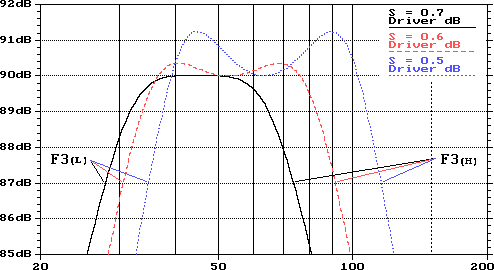 |
Sealed Rear Chamber Bandpass Sub Woofer Design Tips |
 |
Explanation of Terms |
 |
Qts, Vas, and Fs, are the electro-mechanical parameters for your woofer. They are also commonly referred to as the "Thiele-Small" parameters. You can get these from the paperwork that came with your speakers, from the dealer where you purchased your speakers, or from the manufacturer of the speaker (they are sometimes hard to contact, however). |
 |
S Factor - refers to the efficiency of the enclosure. 0.7 is the most efficient, however, it also has the narrowest passband. 0.5 is the least efficient, but it has the widest passband. Another drawback to the lower S Factor designs is that they have more passband ripple (the sag in the frequency response plot in Figure 1). Higher S factor enclosure designs also exhibit better transient response.
One of the reasons bandpass enclosures are so popular is this inherent property that allows the designer the flexibility to trade bandwidth for efficiency or vice versa. |
 |

Figure 1 |
 |
F3(L) - the frequency where the response is down by 3 dB (on the low end of the passband - see Figure 1). This will be the first number in the "Passband" box when you calculate an enclosure. |
 |
F3(H) - the frequency where the response is down by 3 dB (on the high end of the passband - see Figure 1). This will be the second number in the "Passband" box when you calculate an enclosure. |
 |
Vf - the internal volume of the front (vented) chamber of the enclosure. |
 |
Vr - the internal volume of the rear (sealed) chamber of the enclosure. |
 |
Qbp - is the total resonance of the speaker system. Essentially the same as Qtc is in a sealed design. |
 |
Fb - the frequency that the vent in the front chamber of the enclosure needs to be tuned to. |
 |
Passband - refers to the range of frequencies that will be allowed to pass through the speaker system (the frequencies you will be able to hear/feel). Any frequencies above or below the passband will be attenuated (reduced). |
 |
Gain - the amount of boost(or in some designs the amount of attenuation) in sound pressure level(SPL). This is usually referred to in speaker design with other terms, which serve to make it a valid reference point. A typical specification for a bandpass enclosure would be :
Efficiency/Sensitivity : 94 dB SPL @ 1W/1M.
This means that this design is capable of creating a sound pressure level of 94 dB when a signal of 1 watt is applied to it, and is measured with the measuring instrument 1 meter (approximately 3.28 feet) in front of the speaker system. |
 |
 |

Typical Fourth-Order Bandpass
Enclosure Design |
 |
General Design Tips |
 |
- Always add the volume displaced by the speaker's motor system (the magnet, frame, and the suspension), and all bracing materials to your enclosure's rear chamber volume when designing a speaker system.
- If you add damping material (fiberglass, Acousta-Stuf™ polyfill, Dacron™, etc...), you can design the rear chamber of your enclosure 10% smaller than the suggested ideal size. I usually use 3/4-1 lb. per cubic foot (polyfill) of enclosure volume. I prefer not to use fiberglass because there is a chance that the fibers can get in the voice coil, and also because of the health hazards (skin & lung irritation) that are possible when working with this material.
- You should also take the volume consumed by your port(s) into account when designing the front chamber of your bandpass enclosure (unless you're designing an enclosure with the vent on the outside of the box).
- Some people feel that because a bandpass enclosure naturally attenuates the higher frequencies a lowpass filter is unneccessary, this is false. Bandpass enclosures create standing waves in the front chamber of the enclosure which cause peaks in the frequency response. In my opinion, sub woofers sound much better when they are not receiving any high frequencies. So, always use a lowpass filter (or a notch filter) on any bandpass sub woofer design.
- I do not put damping material in the front chamber of bandpass enclosures because it can shift around in the enclosure and interfere with vent operation unless it is very securely attached. I do however, cover all of the interior walls of the front chamber with carpet underlayment (padding - put the hard side toward the wood if the type you get has a side with a sealing layer on it). I believe this helps to suppress the standing waves created in the front chamber. I have also heard that felt works well when used in this application - I have never tried it though.
- Before you attach the last panel of your enclosure, apply silicone to all of the joints in the enclosure, and also seal the back of any wiring terminal cups (if a gasket was not provided with it). Let the silicone fully cure (read the label and follow all of the instructions) before putting on the last panel. I install the damping material at this time while waiting for the silicone to dry.
|
 |
- Build your enclosure using the thickest, hardest, non-resonant material you can get your hands on. I use 3/4" (minimum) medium density fiberboard (MDF). Solid wood is not a good choice for enclosure construction - although hardwoods do make excellent bracing material. You can use some types of plywood - it has to be marine grade though (which can be expensive). The last choice is particle board - this material is flimsy and it is hard to make solid enclosure joints with, but if you cannot get MDF in your area you can use this (brace the enclosure very thoroughly if you do).
|
 |
- For some excellent advice on bracing your speaker enclosure, click here.
|

